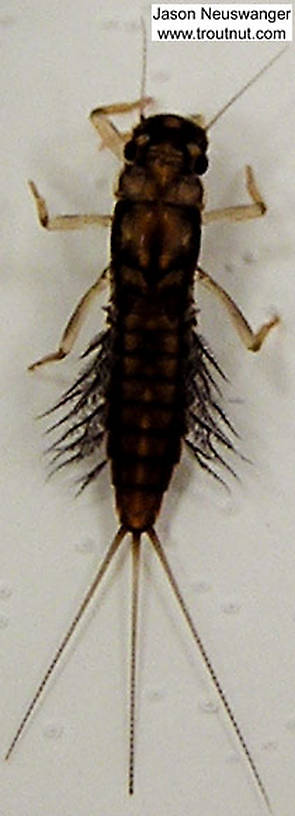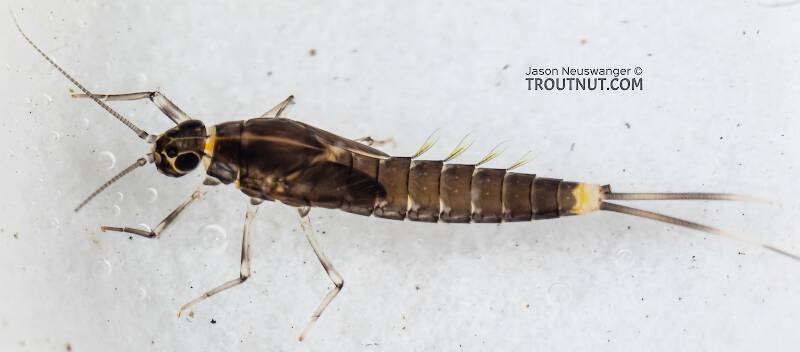
Blue-winged Olives
Baetis
Tiny Baetis mayflies are perhaps the most commonly encountered and imitated by anglers on all American trout streams due to their great abundance, widespread distribution, and trout-friendly emergence habits.
Featured on the forum

Some characteristics from the microscope images for the tentative species id: The postero-lateral projections are found only on segment 9, not segment 8. Based on the key in Jacobus et al. (2014), it appears to key to Neoleptophlebia adoptiva or Neoleptophlebia heteronea, same as this specimen with pretty different abdominal markings. However, distinguishing between those calls for comparing the lengths of the second and third segment of the labial palp, and this one (like the other one) only seems to have two segments. So I'm stuck on them both. It's likely that the fact that they're immature nymphs stymies identification in some important way.

Troutnut is a project started in 2003 by salmonid ecologist Jason "Troutnut" Neuswanger to help anglers and
fly tyers unabashedly embrace the entomological side of the sport. Learn more about Troutnut or
support the project for an enhanced experience here.
Dark Brown Spinners
Like most common names,"Dark Brown Spinner" can refer to more than one taxon. They're previewed below, along with 9 specimens. For more detail click through to the scientific names.
Mayfly Genus Paraleptophlebia
These are very rarely called Dark Brown Spinners.
There are many species in this genus of mayflies, and some of them produce excellent hatches. Commonly known as Blue Quills or Mahogany Duns, they include some of the first mayflies to hatch in the Spring and some of the last to finish in the Fall.
In the East and Midwest, their small size (16 to 20, but mostly 18's) makes them difficult to match with old techniques. In the 1950s Ernest Schwiebert wrote in Matching the Hatch:
Fortunately, modern anglers with experience fishing hatches of tiny Baetis and Tricorythodes mayflies (and access to space-age tippet materials) are better prepared for eastern Paraleptophlebia. It's hard to make sense of so many species, but only one is very important and others can be considered in groups because they often hatch together:
In the East and Midwest, their small size (16 to 20, but mostly 18's) makes them difficult to match with old techniques. In the 1950s Ernest Schwiebert wrote in Matching the Hatch:
"The Paraleptophlebia hatches are the seasonal Waterloo of most anglers, for without fine tippets and tiny flies an empty basket is assured."
Fortunately, modern anglers with experience fishing hatches of tiny Baetis and Tricorythodes mayflies (and access to space-age tippet materials) are better prepared for eastern Paraleptophlebia. It's hard to make sense of so many species, but only one is very important and others can be considered in groups because they often hatch together:
- Paraleptophlebia adoptiva is by far the most important species of this genus in the two regions and is an early Spring emerger.
- Paraleptophlebia mollis, Paraleptophlebia guttata, and Paraleptophlebia strigula complement each other in late spring and early summer.
- Paraleptophlebia debilis and Paraleptophlebia praepedita occur together in the fall.
- The most important species is Paraleptophlebia debilis. This large (for the genus) Fall emerger can be found throughout the region. It is often accompanied by one of the slightly larger tusked species. Depending on locale, this can be Paraleptophlebia bicornuta (the most common), Paraleptophlebia packii or Paraleptophlebia helena. Check out their hatch pages for distribution information.
- Spring is the season for the smaller Paraleptophlebia heteronea throughout most of the region with Paraleptophlebia gregalis filling this niche in California and parts of Oregon.
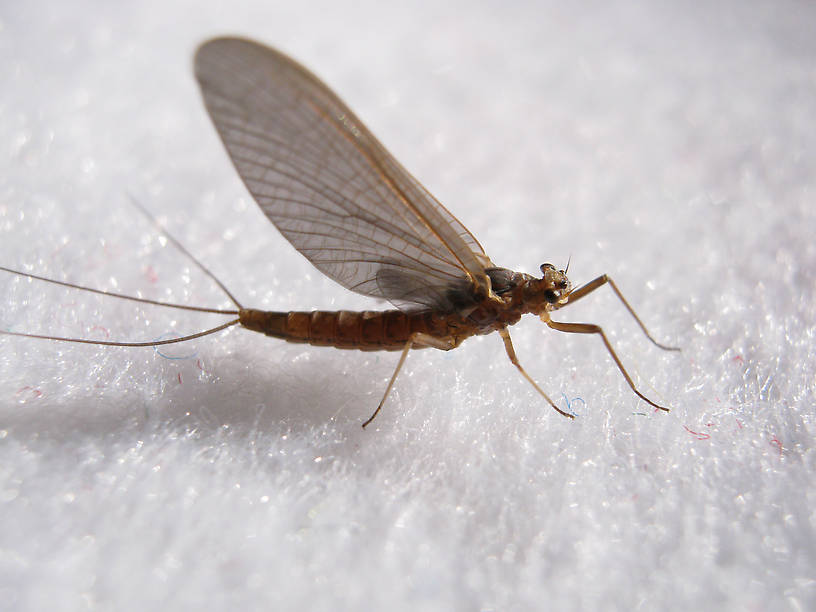
Size: 9mm. These photos really highlight the brown pigmentation of the wing venation, but in the hand the wings look to be a uniform smokey gray. - Entoman

This specimen (and a few others I collected but didn't photograph) appear to represent the first finding of Paraleptophlebia sculleni outside the Oregon Cascades, although it is not a monumental leap from there to the Washington Cascades. The key characteristics are fairly clear.
See 18 more specimens...
Mayfly Species Tricorythodes allectus
These are very rarely called Dark Brown Spinners.
Mayfly Species Drunella coloradensis
These are very rarely called Dark Brown Spinners.
This species is very similar to Drunella flavilinea. In areas where their ranges overlap, they can sometimes be found in the same streams. They are similar enough that anglers sometimes refer to either or both species as "Flavs." Allen and Edmunds (1962) say that Drunella coloradensis tends to favor colder water than Drunella flavilinea and that it may emerge as much as a month later.
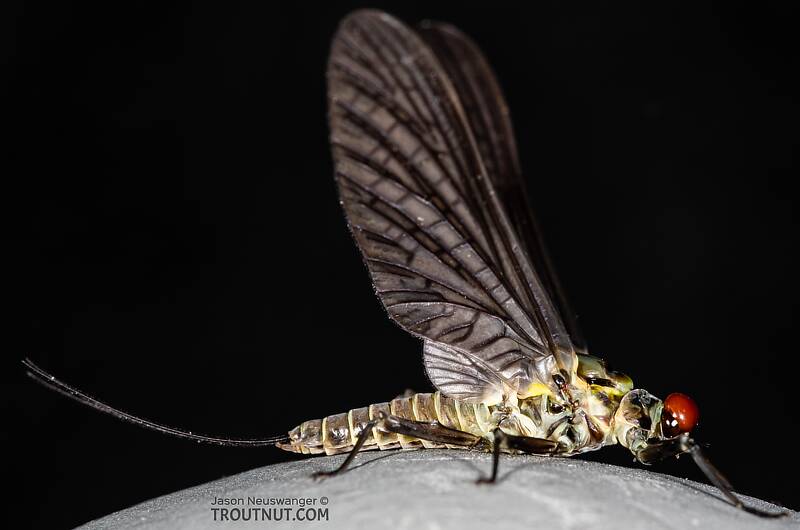
The positive species ID on this dun comes from both the spinner that it (or possibly one other dun just like it) molted into and the overwhelming abundance of nymphs of this species in my kicknet samples from the same site.
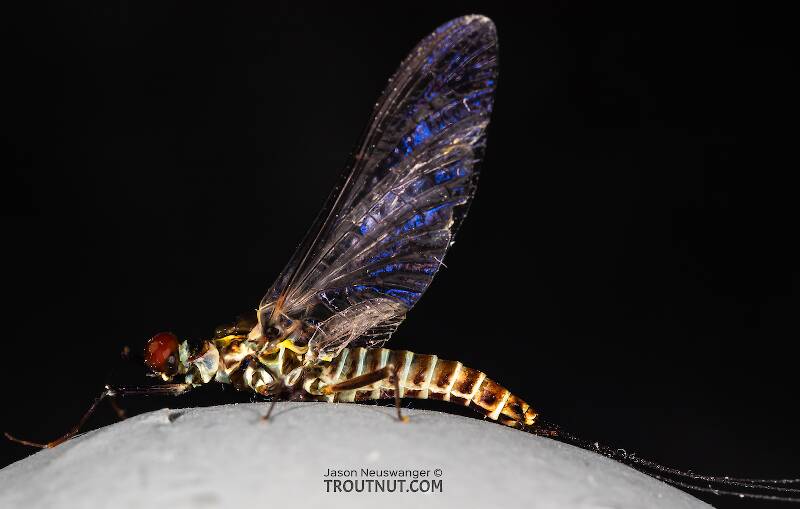
This spinner molted from this dun, or possibly one other dun I had in the same container that looked just like it.

This one nicely illustrates the variation in coloration within an single Ephemerellid species in a single stream, when compared to its lighter, banded counterpart.
See 7 more specimens...
Mayfly Species Ameletus cooki
These are very rarely called Dark Brown Spinners.
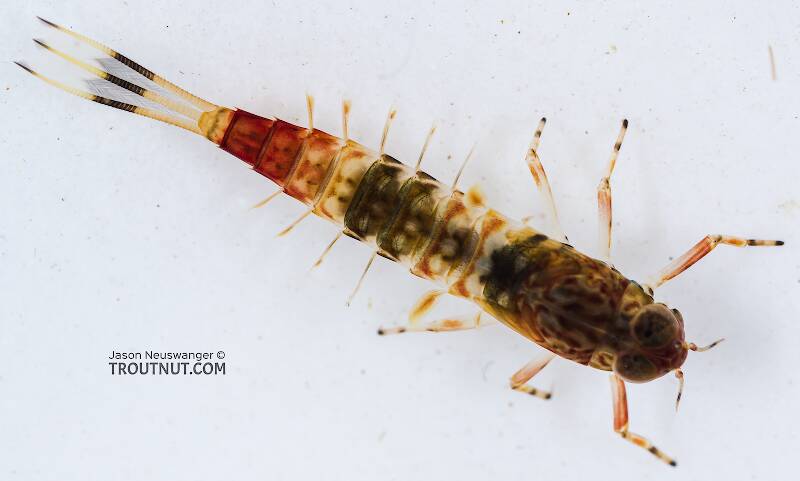
I caught this Ameletus nymph with several others of the same kind. This was the most vivid example, but they all had quite a bit of striking and unusual red shading, especially on the last few abdominal segments.
I keyed it out under the microscope using Larvae and adults of Ameletus mayflies (Ephemeroptera: Ameletidae) from Alberta with slightly larger (10 mm), mature specimen with darkened wingpads. Microscope pictures are from that specimen. The characteristics in the key and most of the verification table point pretty clearly to Ameletus cooki, except that the coloration of the antennae more closely resembles Ameletus sparsatus. However, on other characteristics in which these species differ (spines on the dorsal surface of the front femora, which seem very short in this specimen; length of posterolateral spines on segments 8–9; length of spines on posterior edge of tergites 6–9), this is a better match for cooki, and that's probably the correct ID.
I keyed it out under the microscope using Larvae and adults of Ameletus mayflies (Ephemeroptera: Ameletidae) from Alberta with slightly larger (10 mm), mature specimen with darkened wingpads. Microscope pictures are from that specimen. The characteristics in the key and most of the verification table point pretty clearly to Ameletus cooki, except that the coloration of the antennae more closely resembles Ameletus sparsatus. However, on other characteristics in which these species differ (spines on the dorsal surface of the front femora, which seem very short in this specimen; length of posterolateral spines on segments 8–9; length of spines on posterior edge of tergites 6–9), this is a better match for cooki, and that's probably the correct ID.
Mayfly Species Teloganopsis deficiens
These are very rarely called Dark Brown Spinners.
Anglers in western Wisconsin, where these little flies hatch in good numbers on summer rivers, have termed them "Darth Vaders" because of the very dark color of their wings.
Until recently, this species was known as Serratella deficiens.
Until recently, this species was known as Serratella deficiens.
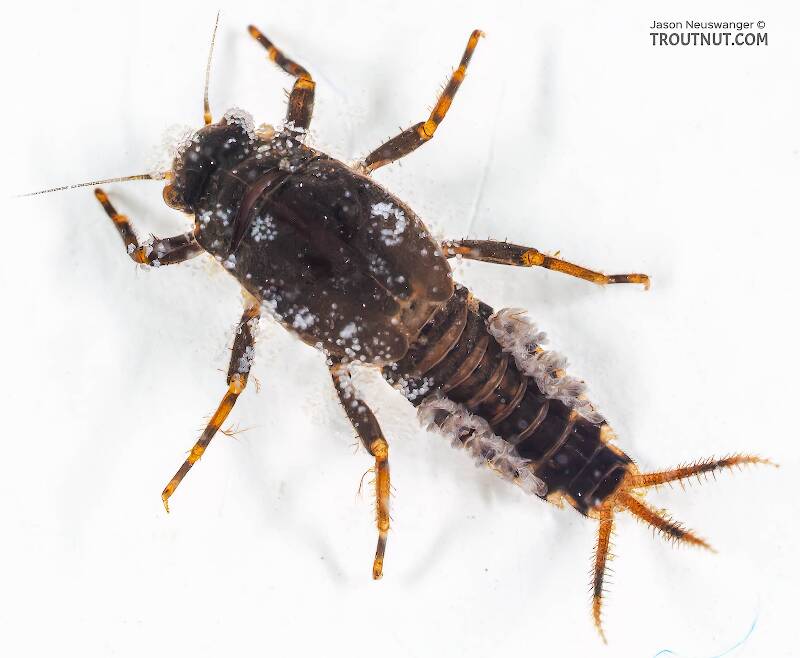
This nymph has tiny, barely detectable tubercles on its abdominal segments, and I could not find the maxillary palpi. I tentatively guessed that it is Serratella deficiens back when that was a thing; the species is now known as Teloganopsis deficiens. One of the key characteristics, tarsal claws with a subapical denticle being larger than the preceding denticles, seems to be visible in some of the pictures.
Mayfly Species Tricorythodes explicatus
These are very rarely called Dark Brown Spinners.
This hatch is fairly well-known to anglers under its former name Tricorythodes minutus, which was one of the species responsible for good Trico fishing.
Mayfly Species Diphetor hageni
These are very rarely called Dark Brown Spinners.
This is one of the most important species of the Baetidae family. It is distributed across the country but most of its fame comes from excellent hatches in the West. Prior to many other former species being combined with Baetis tricaudatus, most angling literature considered it the most populous and widespread western species of the Baetidae family.
References
- Jacobus, L. M., Wiersema, N.A., and Webb, J.M. 2014. Identification of Far Northern and Western North American Mayfly Larvae (Insecta: Ephemeroptera), North of Mexico; Version 2. Joint Aquatic Science meeting, Portland, OR. Unpublished workshop manual. 1-176.
- Schwiebert, Ernest G. 1955. Matching the Hatch. MacMillan Publishing Company.


